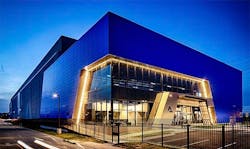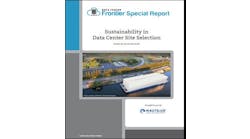Environmental Stewardship Begins with Sustainable Infrastructure
And yet, while the world’s largest organizations providing cloud computing, content and other internet services tend to operate their data centers very efficiently, on average, energy efficiency across legacy infrastructure has for many years been relatively flatlining.
In fact, power usage effectiveness (PUE) values have improved only marginally since 2013, although overall energy efficiency of IT has improved since more work is being produced in larger, more efficiently designed facilities such as hyperscale and cloud data centers. Determined by dividing the amount of power entering a data center by the power used to operate the computing infrastructure within it, PUE is expressed as a ratio, with overall efficiency improving as the quotient decreases toward 1.
Total energy usage for a data center includes energy consumed by servers and by facility overhead functions such as lighting, heating and cooling. In an ideal world, PUE would be 1.0, indicating that all the power consumed by a data center is being used to power its servers. But according to the Uptime Institute’s 11th Annual Global Data Center Survey, in 2021, the average annualized legacy data center was 1.57, a minor improvement over 2020’s average of 1.59 that is consistent with the overall trend of PUE stagnation over the past five years. Contrast these figures with the average PUE for all Google data centers, which the company reports is 1.10.
An additional concern is that despite the growing threat of water scarcity, the Uptime survey found that only half of organizations collect water usage data for their IT and data center operations. The reality is that many of the data centers we see today still reflect the needs and limitations of legacy computing environments that originated decades ago.
Demand for Digital Services Is Hotter Than July
Not too long ago, environmentally conscious energy decision-making was a secondary priority across the data center industry. But today, sustainability has become a critical corporate value as consumers and even investors across a range of industries increasingly pressure organizations to become more responsible stewards of the environment.
That said, even so-called “green” data centers may not be powered exclusively by renewable sources in the very near future, given their high energy consumption and 24/7/365 workloads that require remaining connected to local and reliable sources of power, at least in part. And, while ready access to renewable power options has become a key criterion in the data center location selection process for new builds and expansions, other sustainability challenges persist. For example, there is the challenge of accommodating for high, mixed, and variable density environments, which many data center models fail to accomplish, leading to stranded power and space capacity. Additionally, because cooling systems often comprise an outsize proportion of total data center energy consumption, hot climates present a particularly difficult challenge, significantly impacting OpEx.
True Sustainability Starts with Design
For these and other reasons, sustainable data centers start with design and how the platform is created. The more dynamic the platform design, the more it can cater to varying density and computing requirements to achieve greater business value with less costly energy and infrastructure resources. Utilizing data center assets to their fullest extent possible and ensuring that no idle systems consume electricity is also critical. By design, a highly efficient data center should support high, mixed, and variable density without stranding capacity or creating other inefficiencies and can handle variable power draws.
In legacy layouts, addressing mixed and variable densities and eliminating hot spots is still often accomplished by overcooling. Pushing cold air into a data hall versus removing heat at the source is extremely inefficient and costly. Investing in a cooling technology that utilizes less energy and consumes less water, with the ability to run waterless as required, is an effective way to reduce resource usage, while also mitigating environmental impact, lowering the Total Cost of Operation (TCO), and addressing the need to manage varying power densities. This is a marked advantage to the customer seeking to establish a new availability zone in a geographic region that does not offer a naturally temperate environment, or to a large enterprise that requires a data center presence in Phoenix, where July temperatures can reach 115 degrees Fahrenheit.
A Shared Vision of a Sustainable Future
There’s no question we are living through an extraordinary chapter in the history of the internet — a period that has seen business and society undergo digital transformation not over the course of two or three years, but virtually overnight. There’s also no question that business and society will remain dependent upon data and data centers as we become immersed in the next wave of technology, including IoT-enabled devices, autonomous vehicles, augmented and virtual reality (AR/VR), and smart city systems and applications.
Hence, for today as well as tomorrow, it behooves organizations to capture every energy efficiency opportunity that is available to them, including adaptable data centers that can seamlessly scale to accommodate their unpredictable usage and growth models. For the data center industry, and our customers, environmental stewardship needs to begin with sustainable infrastructure.
Phill Lawson-Shanks is Chief Innovation Officer at Aligned. Contact them to learn more about their adaptive and sustainable approach to data centers.





